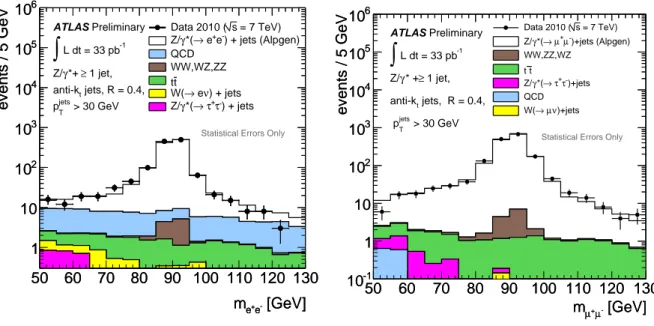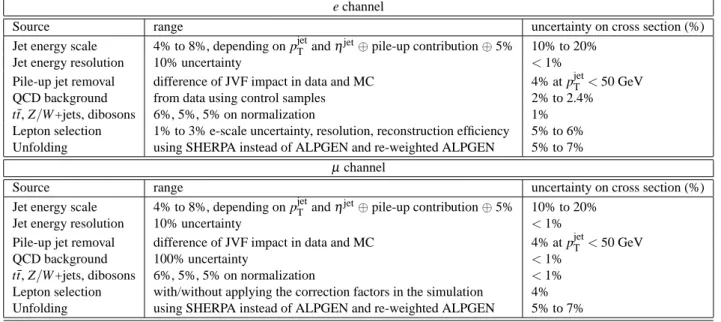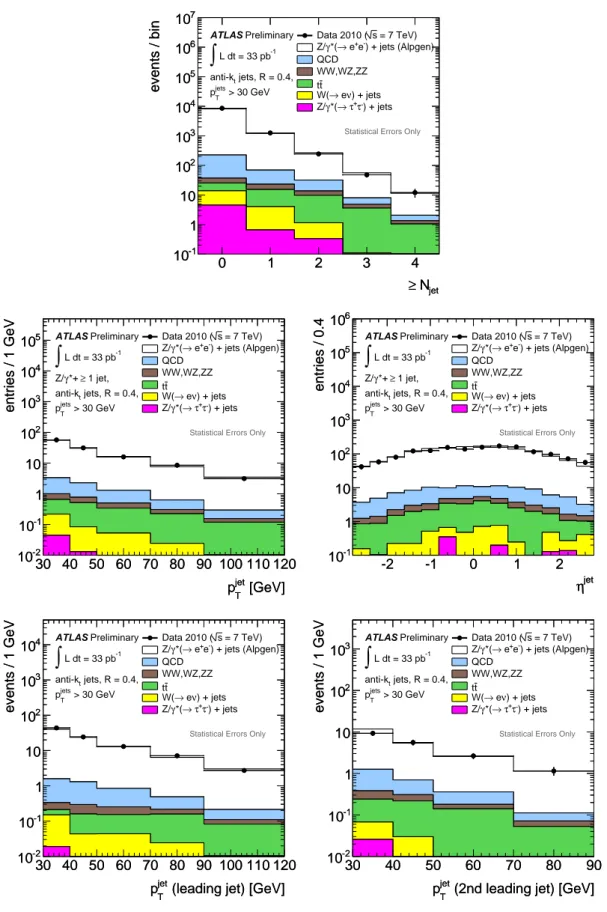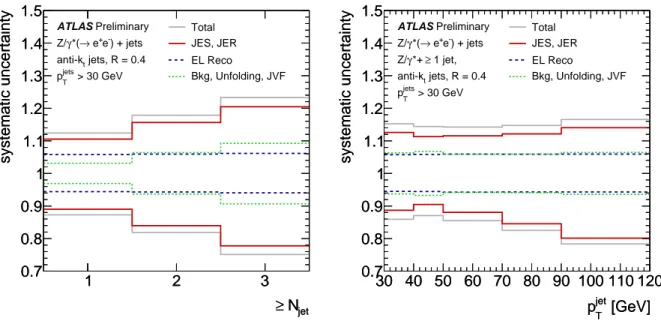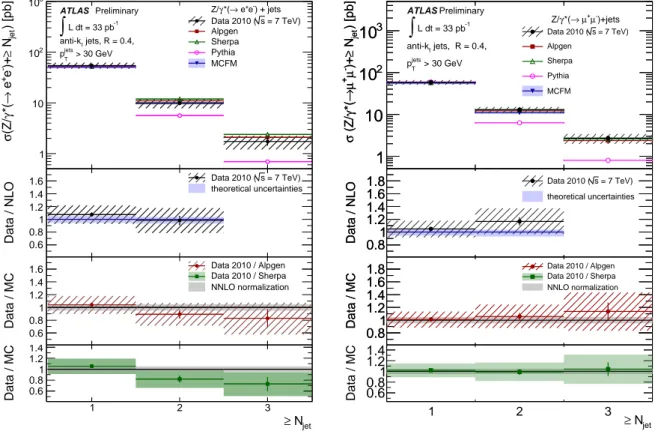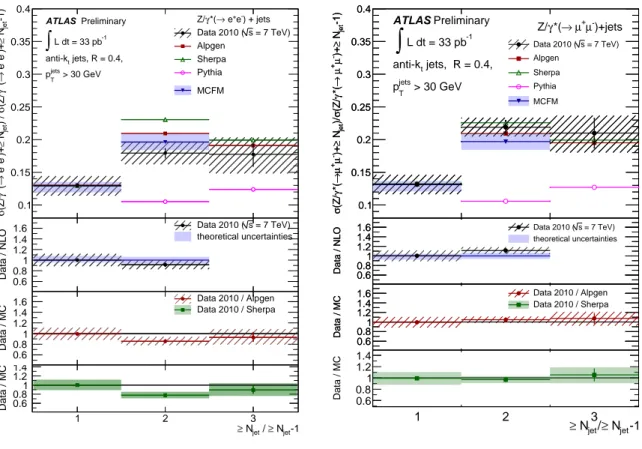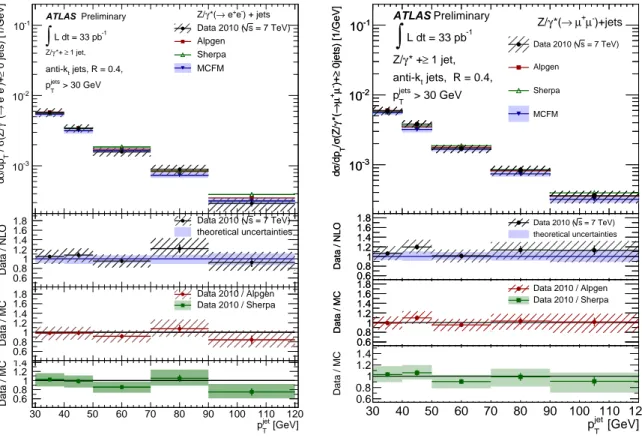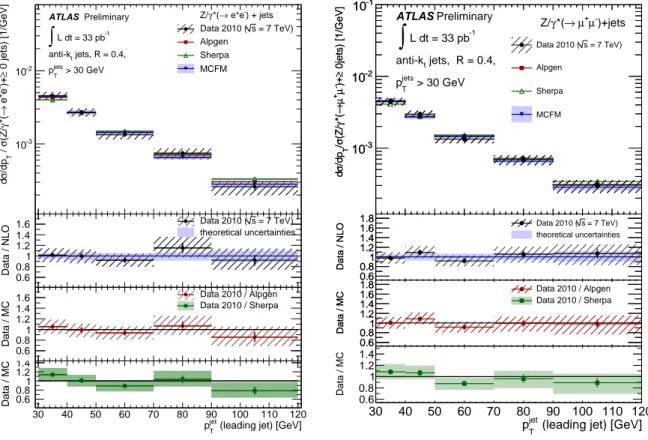ATLAS NOTE
ATLAS-CONF-2011-042 March 19, 2011
Measurement of the production cross section for Z/γ
∗in association with jets in pp collisions at √
s = 7 TeV with the ATLAS Detector
ATLAS Collaboration
Abstract
We report preliminary results on the production of jets of particles in association with a Z/γ∗ boson in the final state, in proton-proton collisions at√
s=7 TeV with the ATLAS detector. The analysis considers the full 2010 data set corresponding to an integrated lu- minosity of 33 pb−1. Inclusive jet cross sections in Z/γ∗ events, with Z/γ∗ decaying into electron or muon pairs, are measured as a function of jet transverse momentum and jet mul- tiplicity, for jets with transverse momentum pjetT >30 GeV and jet pseudorapidity in the region|ηjet|<2.8. The measurements are compared to next-to-leading-order perturbative QCD calculations, and to predictions from different Monte Carlo generators implementing leading-order matrix elements supplemented by parton showers.
1 Introduction
The study of the production of jets of particles in association with a Z/γ∗ boson in proton-proton col- lisions at√
s=7 TeV provides a stringent test of perturbative quantum chromodynamics (pQCD). The proper understanding of events containing QCD jets in association with a Z/γ∗ boson in the Standard Model (SM) is a fundamental element of the LHC physics program of searches for new physics, for which events with such final states constitute irreducible backgrounds. These SM background contribu- tions are estimated using Monte Carlo (MC) predictions that include leading-order (LO) matrix elements supplemented by parton showers, which a priori are affected by large scale uncertainties and need to be tuned and validated using data.
This note presents measurements of jet production in events with a Z/γ∗ boson in the final state, using 33 pb−1of data collected by the ATLAS experiment in 2010, and updates previous studies based on 1.3 pb−1 [1]. These new results include twenty-five times more statistics, an improved knowledge of the lepton reconstruction, reduced jet energy scale and resolution uncertainties, and SM background estimations partially taken from data. Events are selected with a Z/γ∗decaying into electrons or muons, and the measurements are corrected for detector effects. Inclusive jet differential cross sections as a function of jet transverse momentum 1), pjetT , and total cross sections as a function of jet multiplicity, Njet, are measured in well-defined kinematic regions for the leptons and jets in the final state. The data are compared to next-to-leading order (NLO) pQCD predictions [2], including non-perturbative contributions, and to predictions from several MC programs.
2 The ATLAS detector
The ATLAS detector [3] covers almost the whole solid angle around the collision point with layers of tracking detectors, calorimeters and muon chambers. The ATLAS inner detector (ID) has full coverage in φ and covers the pseudorapidity range |η|<2.5. It consists of a silicon pixel detector, a silicon microstrip detector (SCT), and a transition radiation tracker (TRT) all immersed in a 2 Tesla magnetic field.
High-granularity liquid-argon (LAr) electromagnetic sampling calorimeters, with excellent energy and position resolution, cover the pseudorapidity range|η|<3.2. The hadronic calorimetry in the range
|η|< 1.7 is provided by a scintillator-tile calorimeter, which is separated into a large barrel and two smaller extended barrel cylinders, one on either side of the central barrel. In the end caps (|η|>1.5), LAr hadronic calorimeters match the outer|η|limits of the end cap electromagnetic calorimeters. The LAr forward calorimeters provide both electromagnetic and hadronic energy measurements, and extend the coverage to|η|<4.9.
The muon spectrometer is based on the magnetic deflection of muon tracks in the large superconduct- ing air-core toroid magnets, instrumented with separate trigger and high-precision tracking chambers. A system of three large air-core toroids, a barrel and two end caps, generates the magnetic field for the muon spectrometer in the pseudorapidity range of|η|<2.7. Over most of theη-range, a precision mea- surement of the track coordinates in the principal bending direction of the magnetic field is provided by Monitored Drift Tubes. At large pseudorapidities, Cathode Strip Chambers with higher granularity are used in the innermost plane over 2.0<|η|<2.7. The muon trigger system, which covers the pseudo- rapidity range|η|<2.4, consists of Resistive Plate Chambers in the barrel (|η|<1.05) and Thin Gap Chambers in the end cap regions (1.05<|η|<2.4), with a small overlap in the|η|=1.05 region.
1)The ATLAS reference system is a Cartesian right-handed coordinate system, with the nominal collision point at the origin.
The anti-clockwise beam direction defines the positive z-axis, while the positive x-axis is defined as pointing from the collision point to the centre of the LHC ring and the positive y-axis points upwards. The azimuthal angleφis measured around the beam axis, and the polar angleθis measured with respect to the z-axis. The pseudorapidity is defined asη=−ln(tan(θ/2)).
3 Monte Carlo simulation
Monte Carlo event samples are used to compute detector acceptance and reconstruction efficiencies, de- termine background contributions, unfold the measurements for detector effects, and estimate systematic uncertainties on the final results. Table 1 presents the list of MC samples used.
Samples of simulated Z/γ∗(→ e+e−)+jets and Z/γ∗(→ µ+ µ−)+jets events are generated using ALPGEN v2.13 [4] interfaced to HERWIG v6.510 [5] for parton shower and fragmentation into particles, and to JIMMY v4.31 [6] to model underlying event (UE) contributions. Similar samples are generated using SHERPA [7]. In both cases, CTEQ61L [8] parton density functions (PDFs) are employed, and the samples are normalized to next-to-next-to-leading order (NNLO) pQCD inclusive Drell-Yan predictions as determined by the FEWZ [9] program using MSTW2008 PDFs. In addition, Z/γ∗+jets samples (q ¯q→ Z/γ∗g and qg→Z/γ∗q processes) are produced using PYTHIA v6.421 [10] and HERWIG plus JIMMY with MRST2007LO∗ [11] PDFs. In the case of ALPGEN and PYTHIA samples, events are generated with the ATLAS-MC09 [12] tuned set of parameters to control underlying event (UE) contributions in the final state. PYTHIA samples with different sets of UE-related parameters (DW [13] and AMBT1 [14]), modified levels of initial- and final-state gluon radiation, or with UE contributions turned off, are also considered.
Background samples from W +jets and Z/γ∗(→τ+τ−)+jets final states, and dibosons (WW , W Z, ZZ) processes are generated using ALPGEN with CTEQ61L PDFs normalized to NNLO and NLO pQCD predictions, respectively. Simulated top-quark pair production samples are generated using MC@NLO [15]
and CTEQ6.6 PDFs [16]. Finally, dijet background contributions in the muon channel are simulated us- ing PYTHIA-MC09 QCD samples with MRST2007LO∗PDFs, filtered at generator level to select events containing a muon with transverse momentum above 15 GeV in the final state. In the electron channel, the dijet background contribution is determined using data, as discussed in Section 7.
The MC samples are generated with minimum bias interactions overlaid on top of the hard-scattering event in order to account for the multiple proton-proton interactions in the same beam crossing (pile-up) experienced in the data. The number of minimum bias (MB) interactions follows a Poisson distribution with a mean of two. The MC generated samples are then passed through a full simulation [17] of the ATLAS detector and trigger, based on GEANT4 [18]. The simulated events are reconstructed and analyzed with the same analysis chain as for the data, the same trigger and event selection criteria, and re-weighted such that the distribution of the number of primary vertices matches that of the data.
4 Event selection
The data samples considered in this note were collected with ATLAS tracking detectors, calorimeters, muon chambers, and magnetic fields fully operational, and correspond to a total integrated luminosity of 33 pb−1.
In the case of the Z/γ∗(→ e+ e−)analysis, events are selected online using a trigger logic that re- quires the presence of at least one electromagnetic cluster in the calorimeter with transverse energy above 15 GeV in the region|η|<2.5. Electron reconstruction begins with a seed cluster of ET>2.5 GeV in the second layer of the electromagnetic calorimeter. A matching track is searched for in a broad win- dow of∆η×∆φ=0.05×0.1 amongst all reconstructed tracks with pT>0.5 GeV. The closest-matched track to the cluster barycentre is kept as that belonging to the electron candidate. The final electron candidates have cluster sizes of ∆η×∆φ =0.075×0.175 in the barrel calorimeter and 0.125×0.125 in the end-cap. The transverse energy of these electron candidates is obtained from the corresponding calorimeter clusters. Additional requirements are applied to reject jet background and maintain a good electron identification efficiency. The events are then selected to have exactly two oppositely charged
Physics process Generator σ×Br (nb) Z/γ∗(→ll)+jets, l=e,µ,τ (mll>40 GeV, 0≤Nparton≤5) ALPGEN 1.07 (NNLO) Z/γ∗(→ll)+jets, l=e,µ (mll>60 GeV, 0≤Nparton≤4) SHERPA 0.99 (NNLO) Z/γ∗(→ll)+jets, l=e,µ (mll>40 GeV, ˆpt >10 GeV) PYTHIA 0.47 (LO) Z/γ∗(→ll)+jets, l=e,µ (mll>40 GeV, ˆpt >10 GeV) HERWIG+JIMMY 0.37 (LO)
W(→lνl)+jets, l=e,µ ALPGEN 10.46 (NNLO)
t ¯t (lepton + X final state) MC@NLO 0.16 (NLO+NLL)
WW+W Z+ZZ (2 leptons + X final state, 0≤Nparton≤3) ALPGEN 0.007 (NLO) Dijets (b¯b+c ¯c, muon filter pT>15 GeV) PYTHIA 102.3 (LO)
Table 1: Details of MC samples employed in the analyses. The third column tabulates cross section times branching ratio theoretical values used to normalize the different MC samples (see Section 3). The Z/γ∗+jets samples generated with ALPGEN and SHERPA are normalized using next-to-next-to-leading order pQCD predictions for inclusive Z/γ∗ production. PYTHIA and HERWIG+JIMMY Z/γ∗+jets samples are generated using leading-order pQCD matrix elements for 2→2 processes (q ¯q→Z/γ∗g and qg→Z/γ∗q) with a minimum ˆpt, where ˆpt is the transverse momentum defined in the rest frame of the hard interaction.
reconstructed ’medium’ electrons2) with transverse energy ETe >20 GeV, pseudorapidity in the range
|ηe|<2.47 (where the transition region between calorimeter sections 1.37<|ηe|<1.52 has been ex- cluded), and a dilepton invariant mass in the range 66<Me+e−<116 GeV3).
The Z/γ∗ (→ µ+ µ−) sample is collected online using a trigger logic that requires the presence of a muon candidate reconstructed in the muon spectrometer consistent with having originated from the interaction region, with pT >10 GeV or pT >13 GeV (depending on the data period and with the majority of the data taken with the highest threshold) and |η|<2.4. The muon candidates are associated with track segments reconstructed in the inner detectors which, combined with the muon spectrometer information, define the final muon track. Combined muon tracks with pµT >20 GeV and
|ηµ|<2.4 are selected. A number of quality requirements are applied to the muon candidates: the associated inner detector track segment is required to have at least 1, 6, and 6 hits in the pixel, SCT and TRT detectors, respectively, where the TRT requirement is only applied for tracks within|η|<1.9;
the difference between the track pT, as determined using muon stations or inner detectors separately, pMST and pIDT respectively, is required to fulfill |pMST −pIDT |<0.5pIDT and pMST >10 GeV; the muon impact parameters with respect to the reconstructed primary vertex are required to be <0.1 mm and
<10 mm in the r−φ and r−z planes, respectively; the scalar sum of the transverse momenta of the tracks in anη−φ cone of radius 0.2 around the muon candidate is required to be less than 10% of the muon pT. Finally, events are selected with exactly two oppositely charged muons and an invariant mass 66<Mµ+µ−<116 GeV.
In both analyses, events are required to have a reconstructed primary vertex with z-position within 20 cm of the nominal interaction point and with at least 3 tracks associated to it, which suppresses beam- related background contributions and cosmic rays. The final selected dilepton samples contain a total of 8561 and 11665 events for the electron and muon channels, respectively.
2)For a detailed description of the electron selection requirements see [19].
3)The dilepton invariant mass range is wider than the one previously used in [1].
5 Jet reconstruction
Jets are defined using the anti-kt jet algorithm [20] with the distance parameter set to R=0.4. Energy depositions in calorimeter clusters are employed as input to the jet algorithm in data and MC simulated events 4). The same algorithm is applied to final state particles in the MC generated events to define jets at the particle level5). The measured jet angular variables,ηjet andφjet are reconstructed with no significant shift and a resolution better than 0.05, which improves as the jet transverse momentum, pjetT , increases. The measured jet pjetT is corrected to the true jet energy [21] using an average correction, computed as a function of jet transverse momentum and pseudorapidity, and extracted from inclusive jet MC samples. In this analysis, events are required to have at least one jet, with corrected transverse momentum pjetT > 30 GeV and pseudorapidity |ηjet|<2.8, which is well separated from the final state leptons from the Z/γ∗ decay. Jets within a cone of radius 0.5 around any selected lepton are not considered. Finally, the contribution from jets originating from pile-up, in data and MC simulated events, is suppressed using the tracking information within the jets. A track is associated with a jet if it lies inside a cone of radius 0.4 around the jet direction. For each jet, the jet vertex fraction (JVF) is defined as the ratio of the scalar sum of the pT of the tracks inside a jet and pointing to the primary vertex, and the total scalar sum of the tracks associated to the jet. Jets with a JVF value below 0.75 are rejected if they are within the pseudorapidity region covered by the ATLAS ID and have tracks associated. For the data sample considered in this analysis, the JVF requirement removes up to 6% of the jets at low pjetT and translates into a net 4% to 5% reduction of events as the jet multiplicity increases. The final sample for Z/γ∗ (→ e+ e−)+jets contains 1249, 244, 48, and 12 events with at least one, two, three, and four jets in the final state, respectively. Similarly, the Z/γ∗(→ µ+ µ−)+jets sample contains 1648, 364, 79, and 18 events with at least one, two, three, and four jets in the final state, respectively.
6 Lepton reconstruction
For this analysis, Z/γ∗ (→ e+ e−) and Z/γ∗ (→ µ+ µ−)data samples have been used, together with the world average values for the Z boson mass and width, to determine the absolute scale and resolution of the energy/momentum of the leptons, validate calibration- and alignment-related constants in data, and check the MC description [22]. In addition, the trigger and offline lepton reconstruction efficiencies are studied in situ using control samples in data, and the results are compared to the simulation. The differences observed between data and MC predictions define scale factors, which are applied in the analysis to the simulated samples before they are used to correct the measurements for detector effects.
For the Z/γ∗ (→ e+ e−) channel, the trigger and offline electron reconstruction efficiencies for single electrons are estimated using W(→eν) and Z/γ∗ (→ e+ e−) events in data and compared to MC predictions. In the kinematic range considered in the analysis, the trigger and offline reconstruction efficiencies per electron are above 99% and 94%, respectively. Within the current statistical precision of the data, they do not present any significant dependence on the jet kinematics. The study indicates a good agreement between data and simulated trigger efficiencies, while the simulation tends to overestimate the offline reconstruction efficiencies. Scale factors in the range between 0.945±0.017 and 0.995±0.029, depending on ηe for ETe >20 GeV, are applied per lepton and event-by-event to the MC samples to account for this effect.
In the Z/γ∗ (→ µ+ µ−) analysis, the trigger and offline muon reconstruction efficiencies are also estimated in situ using the data and compared to simulation. The study of the offline reconstruction efficiency is separated into three factors related to the reconstruction of the muon track in the inner
4)The jet reconstruction uses(x,y,z) = (0,0,0)as a reference to calculate the direction and pTof the input jet constituents.
5)The final state in the MC generators is defined using all particles with lifetime above 10−11s, after excluding the muons from the Z/γ∗decay.
tracker, the reconstruction of the muon candidate in the muon chambers, and the efficiency of the muon isolation requirement. The measured average single muon trigger efficiency is about 85%, independent of pµT, and varies from 80% for|ηµ|<0.63 and 70% for 0.63<|ηµ|<1.05 to 90% for 1.05<|ηµ|<2.4, limited mainly by the trigger chamber acceptance. The measured average offline muon reconstruction efficiency is about 90% and approximately independent of pµTand the jet kinematics. The MC simulation predicts efficiencies similar to those in the data, but tends to overestimate the trigger efficiency by 1%
to 2% and the average offline reconstruction efficiency by about 2.5%. The latter is mainly attributed to an overestimation in the simulated efficiency for the reconstruction of muon candidate in the muon chambers. Separate correction factors are applied in the analysis to take both effects into account.
7 Background estimation
The background contribution to Z/γ∗ (→ e+ e−)+jets and Z/γ∗ (→ µ+ µ−)+jets analyses from SM processes is estimated using MC simulated samples, as discussed in Section 3, with the exception of the dijet background in the electron channel that is estimated using data.
The dijet background contribution in the Z/γ∗(→ e+e−)+jets analysis was estimated using a control data sample, orthogonal to the nominal selection, with two electron candidates passing loose identifica- tion requirements. This sample was employed to determine the shape of the dijet background under the dilepton invariant mass distribution. The fraction of dijet background events in the signal region for each jet multiplicity is extracted from a fit to the measured dilepton invariant mass with nominal lepton re- quirements, using as input the obtained shape of the dijet contribution in data and the MC predictions for the shape of the signal and the rest of the SM background processes. The results are used to determine, for each observable separately, the dijet background contribution.
In the Z/γ∗ (→ µ+ µ−)+jets case, MC predictions were used. As a cross-check, an attempt was made to estimate the dijet background from data, and the results were broadly consistent with the MC predictions. A conservative 100% uncertainty on the predicted dijet background is then adopted as part of the systematic uncertainties (see below).
In the electron channel, the total background increases from 6% to 14% as the jet multiplicity in- creases, and it is dominated by jet processes, followed by contributions from t ¯t and diboson production at large jet multiplicities. In the muon channel, the SM background contribution, as estimated from simu- lation, increases from 1% to 8% as the jet multiplicity increases, dominated by t ¯t and diboson processes.
Figure 1 shows the measured dilepton invariant mass for both electron and muon channels compared to predictions for signal and background, in events with at least one jet in the final state. The measured uncorrected inclusive jet multiplicity in Z/γ∗(→ e+e−)events is presented in Fig. 2, together with the uncorrected inclusive jet pjetT andηjetspectra, the pjetT distribution of the leading jet in events with at least one jet, and the pjetT distribution of the second-leading jet in events with at least two jets in the final state.
Similarly, the uncorrected distributions in Z/γ∗(→ µ+µ−)events are shown in Fig. 3. The data yields are reasonably well described by the simulation in all cases.
8 Unfolding and systematic uncertainties
The measurements are unfolded for detector effects back to the particle level using a bin-by-bin unfold- ing procedure, based on MC simulated samples, that corrects for acceptance and resolution effects and accounts for the efficiency of the Z/γ∗selection. At the particle level, the lepton kinematics in the MC generated samples are defined to include the contributions from the photons radiated within a cone of radius 0.1 around the lepton direction. The ALPGEN samples for Z/γ∗+jets processes provide a satisfac- tory description of both lepton and jet distributions in data and are employed to compute the unfolding
[GeV]
e-
e+
m
50 60 70 80 90 100 110 120 130
events / 5 GeV
1 10 102
103
104
105
106
[GeV]
e-
e+
m
50 60 70 80 90 100 110 120 130
events / 5 GeV
1 10 102
103
104
105
106
ATLAS Preliminary L dt = 33 pb-1
∫
1 jet,
≥ γ*+
Z/
jets, R = 0.4, anti-kt
> 30 GeV
jets
pT
= 7 TeV) s Data 2010 (
) + jets (Alpgen) e-
e+
→ γ*(
Z/
QCD WW,WZ,ZZ
t t
) + jets ν
→ e W(
) + jets τ-
τ+
→ γ*(
Z/
Statistical Errors Only
[GeV]
µ-
µ+
m
50 60 70 80 90 100 110 120 130
events / 5 GeV
10-1
1 10 102
103
104
105
106
[GeV]
µ-
µ+
m
50 60 70 80 90 100 110 120 130
events / 5 GeV
10-1
1 10 102
103
104
105
106
Preliminary ATLAS
L dt = 33 pb-1
∫
1 jet,
≥ γ* + Z/
jets, R = 0.4, anti-kt
> 30 GeV
jets
pT
Statistical Errors Only = 7 TeV) s Data 2010 (
)+jets (Alpgen) µ-
µ+
→ γ*(
Z/
WW,ZZ,WZ t t
)+jets τ-
τ+
→ γ*(
Z/
QCD )+jets ν µ
→ W(
Figure 1: Measured dilepton invariant mass in Z/γ∗(→ e+e−)(left) and Z/γ∗(→ µ+µ−)(right) events with at least one jet with pjetT >30 GeV and|ηjet|<2.8 in the final state. The data are shown in a wider dilepton mass region than the one selected, and compared to MC predictions for signal (ALPGEN) and background processes.
In the Z/γ∗(→ e+e−)case, the dijet background contribution is determined from data.
factors. For each observable, the bin-by-bin unfolding factors are defined as the ratio between the simu- lated distribution, after all selection criteria are applied, and the corresponding distribution at the particle level defined in a limited fiducial kinematic region for the generated leptons and jets, where the detector has a good acceptance (see Sections 4 and 5). The measured uncorrected distributions are multiplied by the unfolding factors to obtain the final result. In the case of the inclusive jet multiplicity, the unfolding factors are about 1.5 for the electron channel and 1.2 for the muon channel, and show a slight dependence on Njet. Similarly, the unfolding factors applied to the measured pjetT distributions increase from 1.47 to 1.55 as pjetT increases in the electron channel, and from 1.17 to 1.22 in the muon channel.
A study of systematic uncertainties on the measured cross sections is carried out (see Table 2). Fig- ures 4 and 5 show, separately for electron and muon channels, the contribution of the different sources of systematic uncertainty to two of the measurements: the inclusive cross section as a function of Njetand the inclusive jet cross section as a function of pjetT , in events with at least one jet in the final state.
• The measured jet energies are varied between 4% and 8%, depending on pjetT andηjet, to account for the absolute jet energy scale (JES) uncertainty, as determined in inclusive jet studies [21].
No correction is applied to account for the average increase of the jet energy due to pile-up. An uncertainty is assigned instead that depends on the jet pjetT andηjet, and the number of reconstructed primary vertices. In the case of two primary vertices per event, this translates into an additional JES uncertainty that varies between 0.8% and 4% at low pjetT for jets in the region 0.3<|ηjet|<0.8 and 2.1<|ηjet|<2.8, respectively. An additional 5% uncertainty on the measured jet energies, independent of pjetT , is conservatively considered to account for the different quark- and gluon-jet relative population in dijet and Z/γ∗+jets final states, leading to a different average calorimeter response. This results in an uncertainty on the measured cross sections that increases from 10% to 20% as Njet and pjetT increase, and constitutes the dominant source of systematic uncertainty. The 10% uncertainty on the jet energy resolution (JER) [21] translates into a less than 1% uncertainty
on the measured cross sections.
• The difference between the impact of the JVF requirement in data and MC simulation is conser- vatively taken as an additional contribution to the total systematic uncertainty. This introduces an uncertainty on the measured cross sections of 1% to 9% as Njetincreases, and about 3% to 4% for pjetT <50 GeV.
• The uncertainty on the estimated dijet background in the electron channel translates into a 0.6% to 6% uncertainty on the measured cross sections as Njetincreases, and into a 2% to 2.4% uncertainty with increasing pjetT. In addition, the background contributions from top quark, W +jets, Z/γ∗(→ τ+τ−)+jets, and diboson production processes are varied by 6%, 5%, 5%, and 5%, respectively, to account for the uncertainty on the cross sections of the different MC samples. This translates into a less than 1% uncertainty in the measured cross sections. In the Z/γ∗ (→ µ+ µ−)+jets measurements, the impact from the background uncertainties is negligible.
• The unfolding factors are re-computed using SHERPA instead of ALPGEN to account for possible dependencies on the parton shower, underlying event, and fragmentation models implemented in the MC samples. In addition, an iterative process is employed to re-weight the ALPGEN MC samples and further improve the description of the measured distributions. New unfolding factors are re-computed using the re-weighted samples and the differences with respect to the nominal ALPGEN unfolding factors are considered a source of systematic uncertainty. This introduces an uncertainty on the measured cross sections that increases from 2% to 6% with increasing Njet, and from 5% to 7% with increasing pjetT.
• The uncertainty on the electron selection is taken into account. It includes uncertainties on the electron absolute energy scale and energy resolution, the uncertainty on the electron identification efficiency, and the uncertainties on the electron reconstruction scale factors applied to the MC simulation. This translates into a 5% uncertainty in the measured Z/γ∗ (→ e+ e−)+jets cross sections, approximately independent of Njet, pjetT , andηjet. The uncertainty on the measured cross sections due to the determination of the electron trigger efficiency is negligible.
• The uncertainty on the muon reconstruction efficiency translates into a 4% uncertainty in the mea- sured Z/γ∗ (→ µ+ µ−)+jets cross sections, approximately independent of Njet, pjetT, and ηjet. Other uncertainties, related to the muon trigger efficiency, the muon momentum scale, and the muon momentum resolution translate into a less than 1% uncertainty on the measured cross sec- tions.
The different sources of systematic uncertainty are added in quadrature to the statistical uncertainty to obtain the total uncertainty. The total systematic uncertainty increases from 13% to 24% as Njet
increases; and from 15% at low pjetT to 25% at very high pjetT . Finally, an additional 3.4% uncertainty on the total integrated luminosity [23] is also taken into account.
9 Next-to-leading order pQCD predictions
Inclusive NLO pQCD predictions for Z/γ∗ (→ e+ e−)+jets and Z/γ∗ (→ µ+ µ−)+jets production, with up to two jets in the final state, are computed using the MCFM program [2]. CTEQ6.6 PDFs [16]
are employed and renormalization and factorization scales are set to µ =HT/2, where HT is defined event-by-event as the scalar sum of the pTof all the particles and partons in the final state. The anti-kt
algorithm with R=0.4 is used to reconstruct jets at the parton level.
e channel
Source range uncertainty on cross section (%)
Jet energy scale 4% to 8%, depending on pjetT andηjet⊕pile-up contribution⊕5% 10% to 20%
Jet energy resolution 10% uncertainty <1%
Pile-up jet removal difference of JVF impact in data and MC 4% at pjetT <50 GeV
QCD background from data using control samples 2% to 2.4%
t ¯t, Z/W +jets, dibosons 6%, 5%, 5% on normalization 1%
Lepton selection 1% to 3% e-scale uncertainty, resolution, reconstruction efficiency 5% to 6%
Unfolding using SHERPA instead of ALPGEN and re-weighted ALPGEN 5% to 7%
µchannel
Source range uncertainty on cross section (%)
Jet energy scale 4% to 8%, depending on pjetT andηjet⊕pile-up contribution⊕5% 10% to 20%
Jet energy resolution 10% uncertainty <1%
Pile-up jet removal difference of JVF impact in data and MC 4% at pjetT <50 GeV
QCD background 100% uncertainty <1%
t ¯t, Z/W +jets, dibosons 6%, 5%, 5% on normalization <1%
Lepton selection with/without applying the correction factors in the simulation 4%
Unfolding using SHERPA instead of ALPGEN and re-weighted ALPGEN 5% to 7%
Table 2: Summary of the systematic uncertainties in the cross sections. The uncertainties are shown only for Njet≥1 and as a range with increasing pjetT .
Systematic uncertainties on the predictions related to PDF uncertainties are computed using the Hes- sian method [24] and are defined as 90% C.L. uncertainties. For the total cross sections, they increase from 1% to 3% with increasing Njet. Additional changes in the PDFs due to the variation of the input value forαs(MZ)by ±0.002 around its nominal valueαs(MZ) =1.118 introduce uncertainties on the measured cross sections that increase from 0.5% to 5% with increasing Njet, and from 2.5% to 5% with increasing pjetT . These are added in quadrature to the PDF uncertainties. Variations of the renormalization and factorization scales by a factor of two (half) reduce (increase) the predicted cross sections by 2.5%
to 6% as Njetincreases, and change by 3% to 9% the predicted inclusive jet differential cross sections as pjetT increases.
The theoretical predictions are corrected for QED radiation effects. The correction factors are de- termined using ALPGEN MC samples with and without photon radiation in the final state, defined by the lepton four-momentum and photons within a cone of radius 0.1 around the lepton direction. The correction factors are about 2% for the electron and muon channels, and do not present a significant Njet dependence.
Finally, the theoretical predictions include parton-to-hadron correction factors that approximately ac- count for non-perturbative contributions from the underlying event and fragmentation into particles. In each measurement, the correction factor is estimated using PYTHIA MC samples, as the ratio between the nominal distribution and the one obtained by turning off both the interactions between proton rem- nants and the string fragmentation in the MC samples. In addition, the non-perturbative corrections are computed using HERWIG+JIMMY and different PYTHIA MC samples with modified parton shower and UE settings, as discussed in Section 3. The non-perturbative corrections reduce the theoretical pre- dictions by about 4% and exhibit a moderate Njetand pjetT dependence.
10 Results
The measurements presented in this note are corrected for detector effects and refer to particle level jets identified using the anti-kt algorithm with R=0.4, for jets with pjetT >30 GeV and|ηjet|<2.8. The
results are defined in a limited kinematic range for the Z/γ∗ decay products. In the electron channel, the measured cross sections refer to the region: 66<Me+e− <116 GeV, ETe>20 GeV, 0<|ηe|<1.37 or 1.52<|ηe|<2.47, and∆R(jet−electron)>0.5. Similarly, in the muon case the measurements are presented in the region: 66<Mµ+µ− <116 GeV, pµT >30 GeV, |ηµ|<2.4, and ∆R(jet−muon)>
0.5. The data are compared to the predictions from the different MC event generators implementing Z/γ∗ (→ e+ e−)+jets and Z/γ∗(→ µ+ µ−)+jets production, as discussed in Section 3, as well as to NLO pQCD predictions, as discussed in Section 9.
Figure 6 presents the measured cross sections as functions of the inclusive jet multiplicity (≥Njet) for Z/γ∗(→ e+ e−)and Z/γ∗ (→ µ+ µ−) interactions, in events with up to at least three jets in the final state. As expected, the measured cross sections decrease with increasing jet multiplicity. The data in the Z/γ∗(→ µ+ µ−) channel are well described by the predictions from ALPGEN, SHERPA and NLO pQCD (the latter only available for the inclusive production of at least one jet and two jets in the final state). In the Z/γ∗(→ e+ e−)channel, the data are well described by the NLO pQCD prediction, while the measurements are slightly below the ALPGEN and SHERPA predictions at large inclusive jet multiplicities. In the case of PYTHIA, the LO pQCD (2→2 processes) MC predictions are multiplied by a factor 1.17, as determined from data and extracted from the average of electron and muon results in the ≥1 jet bin in Fig. 6. This brings the PYTHIA predictions close to the data. However, for larger Njet, and despite the additional normalization applied, PYTHIA predictions underestimate the measured cross sections.
As an improved test of the SM, the measured ratio of cross sections for different jet multiplicities σNjet/σNjet−1is shown in Fig. 7, compared to the different theoretical predictions. The data indicate that the cross sections decrease by a factor of 0.2 with the requirement of each additional jet in the final state.
The Z/γ∗ (→ µ+ µ−) measurements are well described by the ALPGEN, SHERPA and NLO pQCD predictions. The measurements in the Z/γ∗ (→ e+ e−) channel are well described by NLO pQCD predictions, while ALPGEN and SHERPA predictions tend to overestimate the measuredσNjet/σNjet−1
ratio for Njet=2. PYTHIA predictions underestimate the measured ratios.
The inclusive jet differential cross section dσ/d pjetT as a function of pjetT is presented in Fig. 8, for both Z/γ∗ (→ e+ e−)and Z/γ∗(→ µ+ µ−)analyses, in events with at least one jet in the final state.
The cross sections are divided by the corresponding inclusive Z/γ∗cross section,σ(Z/γ∗(→ e+ e−)) and σ(Z/γ∗ (→ µ+ µ−)), measured in the same kinematic region for the leptons, with the aim of cancelling systematic uncertainties related to lepton identification and the luminosity. The measured differential cross sections decrease by almost two orders of magnitude as pjetT increases between 30 GeV and 120 GeV. The data are well described by ALPGEN, SHERPA and MCFM NLO pQCD predictions.
Similar conclusions are extracted from Fig. 9, where the differential cross sections are presented as a function of the leading-jet pjetT .
Finally, Fig. 10 shows the measured differential cross sections dσ/d pjetT, for electron and muon chan- nels, as a function of pjetT of the second leading jet, divided by the inclusive Z/γ∗cross section, in events with at least two jets with pjetT >30 GeV and|ηjet|<2.8 in the final state. The measured cross sections decrease with increasing pjetT , and are well described by ALPGEN, SHERPA and NLO pQCD predic- tions for pjetT >40 GeV. In the region 30 GeV<pjetT <40 GeV, the measured cross section in the muon channel is well described by the different predictions, while the measurement in the electron channel is slightly below the predictions. The latter explains the observed difference already discussed between the data and the MC predictions in Figs. 6 and 7. A detailed comparison of the measurements for the electron and muon channels, taking into account the correlation of the different systematic uncertainties, indicates that the results are consistent with each other. At low pjetT , a 2σ deviation is observed in the electron channel, that is consistent with the hypothesis of statistical fluctuations in the data.
11 Summary
In summary, we report preliminary results for inclusive jet production in Z/γ∗(→ e+e−)and Z/γ∗(→ µ+µ−) events in proton-proton collisions at √
s =7 TeV. The analysis considers the data collected by the ATLAS detector in 2010 and corresponding to a total integrated luminosity of 33 pb−1. Jets are defined using the anti-kt algorithm with R=0.4 and the measurements are performed for jets in the region pjetT >30 GeV and |ηjet|<2.8. The measured cross sections are described by NLO pQCD predictions including non-perturbative corrections, as well as by the predictions from LO matrix elements supplemented by parton showers, as implemented in the ALPGEN and SHERPA MC generators.
References
[1] The ATLAS Collaboration, Measurement of the production cross section for Z/γ∗in association with jets in pp collisions at√
s=7 TeV with the ATLAS Detector, ATLAS-CONF-2011-001.
[2] J. Campbell and R.K. Ellis, Phys. Rev. D 65, 113007 (2002).
[3] The ATLAS Collaboration, G. Aad et al., JINST 3 S08003 (2008).
[4] M.L. Mangano et al., JHEP 01 0307 (2003).
[5] G. Corcella et al., JHEP 0101, 010 (2001).
[6] J. Butterworth, J. Forshaw and M.Seymour, Z. Phys. C 72 637 (1996).
[7] T. Gleisberg, S. Hoeche, F. Krauss, M. Schoenherr, S. Schumann, F. Siegert, J. Winter, JHEP 0902 (2009) 007, [arXiv:hep-ph/0811.4622].
[8] J. Pumplin et al., JHEP 0207 012 (2002).
[9] K. Melnikov, F. Petriello, Phys. Rev. D 74, 114017 (2006), [arXiv:hep-ph/0609070];
R. Gavin, Y. Li, F. Petriello et al., [arXiv:hep-ph/1011.3540].
[10] T. Sj¨ostrand et al., JHEP 05, 026 (2006).
[11] A. D. Martin, W. J. Stirling, R. S. Thorne, and G. Watt, Eur. Phys. J. C 63 189 (2009);
A. Sherstnev and R. S. Thorne, Eur. Phys. J. C 55 553 (2008).
[12] The ATLAS Collaboration, ATLAS MC tunes for MC09, ATL-PHYS-PUB-2010-002 (2010).
[13] The CDF Collaboration, T. Aaltonen et al., Phys. Rev. D 82 034001 (2010).
[14] The ATLAS Collaboration, Charged particle multiplicities in pp interactions atp
(s) = 0.9 and 7 TeV in a diffractive limited phase-space measured with the ATLAS detector at the LHC and new PYTHIA6 tune, ATLAS-CONF-2010-031.
[15] S. Frixione, B.R. Webber, Cavendish-HEP-08/14, [arXiv:hep-ph/0812.0770].
[16] P. M. Nadolsky et al., Phys. Rev. D 78 013004 (2008).
[17] The ATLAS Collaboration, G. Aad et al., Eur. Phys. J. C 70 823(2010).
[18] S. Agostinelli et al., Nucl. Instrum. and Methods A 506, 250 (2003).
[19] The ATLAS Collaboration, G. Aad et al., JHEP 12 060 (2010).
[20] M. Cacciari, G. P. Salam and G. Soyez, JHEP 0804 (2008) 063;
M. Cacciari, G. P. Salam, Phys. Lett. B 641, 57 (2006);
M. Cacciari, G. P. Salam and G. Soyez, http://fastjet.fr/
[21] The ATLAS Collaboration, Update on the jet energy scale systematic uncertainty for jets produced in proton-proton collisions at √
s=7 TeV measured with the ATLAS detector, ATLAS-CONF- 2011-007.
The ATLAS Collaboration, Jet energy scale and its systematic uncertainty for jets produced in proton-proton collisions at√
s=7 TeV measured with the ATLAS detector, ATLAS-CONF-2010- 056.
[22] The ATLAS Collaboration, A measurement of the total W± and Zγ∗ cross sections in the e and µ decay channels and of their ratios in pp collisions at √s=7 TeV with the ATLAS detector, ATLAS-CONF-2011-050.
[23] The ATLAS Collaboration, Updated Luminosity Determination in pp Collisions at √
s=7 TeV using the ATLAS detector, ATLAS-CONF-2011-011.
[24] J. Pumplin et al., Phys. Rev. D 65, 014013 (2002).
Njet
≥
0 1 2 3 4
events / bin
10-1
1 10 102
103
104
105
106
107
Njet
≥
0 1 2 3 4
events / bin
10-1
1 10 102
103
104
105
106
107
ATLAS Preliminary L dt = 33 pb-1
∫
jets, R = 0.4, anti-kt
> 30 GeV
jets
pT
= 7 TeV) s Data 2010 (
) + jets (Alpgen) e-
e+
→ γ*(
Z/
QCD WW,WZ,ZZ
t t
) + jets ν
→ e W(
) + jets τ-
τ+
→ γ*(
Z/
Statistical Errors Only
[GeV]
jet
pT
30 40 50 60 70 80 90 100 110 120
entries / 1 GeV
10-2
10-1
1 10 102
103
104
105
[GeV]
jet
pT
30 40 50 60 70 80 90 100 110 120
entries / 1 GeV
10-2
10-1
1 10 102
103
104
105 ATLAS Preliminary L dt = 33 pb-1
∫
1 jet,
≥ γ*+
Z/
jets, R = 0.4, anti-kt
> 30 GeV
jets
pT
= 7 TeV) s Data 2010 (
) + jets (Alpgen) e-
e+
→ γ*(
Z/
QCD WW,WZ,ZZ
t t
) + jets ν
→ e W(
) + jets τ-
τ+
→ γ*(
Z/
Statistical Errors Only
ηjet
-2 -1 0 1 2
entries / 0.4
10-1
1 10 102
103
104
105
106
ηjet
-2 -1 0 1 2
entries / 0.4
10-1
1 10 102
103
104
105
106
ATLAS Preliminary L dt = 33 pb-1
∫
1 jet,
≥ γ*+
Z/
jets, R = 0.4, anti-kt
> 30 GeV
jets
pT
= 7 TeV) s Data 2010 (
) + jets (Alpgen) e-
e+
→ γ*(
Z/
QCD WW,WZ,ZZ
t t
) + jets ν
→ e W(
) + jets τ-
τ+
→ γ*(
Z/
Statistical Errors Only
(leading jet) [GeV]
jet
pT
30 40 50 60 70 80 90 100 110 120
events / 1 GeV
10-2
10-1
1 10 102
103
104
(leading jet) [GeV]
jet
pT
30 40 50 60 70 80 90 100 110 120
events / 1 GeV
10-2
10-1
1 10 102
103
104 ATLAS Preliminary L dt = 33 pb-1
∫
jets, R = 0.4, anti-kt
> 30 GeV
jets
pT
= 7 TeV) s Data 2010 (
) + jets (Alpgen) e-
e+
→ γ*(
Z/
QCD WW,WZ,ZZ
t t
) + jets ν
→ e W(
) + jets τ-
τ+
→ γ*(
Z/
Statistical Errors Only
(2nd leading jet) [GeV]
jet
pT
30 40 50 60 70 80 90
events / 1 GeV
10-2
10-1
1 10 102
103
(2nd leading jet) [GeV]
jet
pT
30 40 50 60 70 80 90
events / 1 GeV
10-2
10-1
1 10 102
103
ATLAS Preliminary L dt = 33 pb-1
∫
jets, R = 0.4, anti-kt
> 30 GeV
jets
pT
= 7 TeV) s Data 2010 (
) + jets (Alpgen) e-
e+
→ γ*(
Z/
QCD WW,WZ,ZZ
t t
) + jets ν
→ e W(
) + jets τ-
τ+
→ γ*(
Z/
Statistical Errors Only
Figure 2: Uncorrected measured inclusive jet multiplicity, inclusive pjetT andηjetspectra, leading-jet pjetT in events with at least one jet, and second-leading-jet pjetT in events with at least two jets in Z/γ∗(→ e+e−)+jets final states (black dots). Only statistical uncertainties in data are shown. The data are compared to MC predictions for signal (ALPGEN) and SM background processes, as described in Section 3.

